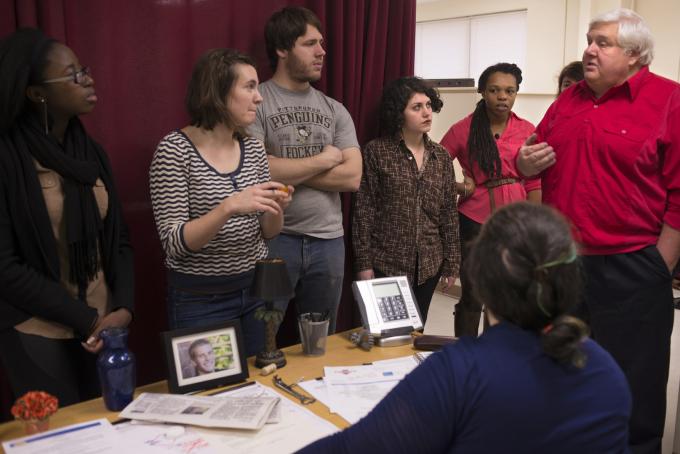CSI: Point Park - Learning Forensic Science in the Crime Scene House

The Point
Spring 2013
Ed Strimlan, M.D., trains Point Park University students to preserve fingerprints at murder scenes, analyze DNA samples in the lab and look for clues next to barely-cold corpses.
Sure, it's fascinating stuff. But the forensic science he teaches is nothing like the plot-twisting, action-packed, tidy heroics on the hit NBC show CSI. "It is like saying Willy Wonka and the Chocolate Factory is like Hershey's," said Strimlan, former chief forensic investigator and assistant professor who now coordinates Point Park's forensic science program.
Related links
Strimlan should know how to distinguish primetime drama from reality. In his 21 years with the Allegheny County Office of the Medical Examiner, he has investigated deaths ranging from the 1994 crash of USAir Flight 427 in Hopewell to the more commonplace tragedy of a toddler choking on a toy.
Since taking the reins in 2010, he has grown Point Park's forensic science program to 51 students, increased basic science requirements for the program and established an on-campus Crime Scene House. Students practice setting up scenes, collecting evidence and looking for clues in the simulated living room, bedroom and study.
Consider a recent case they created, which was inspired by real events. Students arrived to find a man - actually a dummy - face up in bed. Next to him were depressing song lyrics he had written. Pieces of women's clothing were strewn around the room. After finding empty AA battery packaging nearby, students deduced that the man, who was depressed over a breakup, committed suicide by ingesting the missing batteries. If this were a TV crime scene, the apparent suicide may have been a foil to cover up a murder. But Strimlan said he stays away from such scenarios because he has never seen them in real life.
On the Scene
Sometimes theater students create a scene, including one for a missing female. The forensic science students scoured the living room, and Matt Coleman, 22, found the dummy in a fold-out couch, above a pool of fake blood. He and other students deduced that the inebriated girl tripped and hit her head on the corner of the table. Her male colleagues friends had not killed her, but panicked, hiding the body.
Coleman said his professor's real-world experiences lend the simulations authenticity. "Dr. Strimlan can make any kind of crime scene he wants," he said. "He has assisted on thousands of autopsies. He knows science. He knows anatomy. He is like a triple threat in forensics. He is one of the greatest teachers."
Graduating senior Caitlyn Ehmann agreed. "We will set up crime scenes and say, 'That is the best story ever.' He will say, 'Do you really think that would happen?' He makes you open up your eyes and look at all the angles...He teaches you how to ask questions, what to collect."
Ehmann, who interned at the Allegheny County Medical Examiner's office, wants to be a DNA analyst. As an advisor, Strimlan also helps her explore the range of career options.
Unlike the telegenic hero of CSI, real investigators rarely work alone. In fact, Strimlan said the show compresses into one hour what 40 people normally do over about six months.
Real investigations rely on interactions between specialists. To name just a few, the forensic investigator collects evidence, the pathologist performs the autopsy, the serologist analyzes the blood spatter and the odontologist investigates bite marks. The range of available forensic science specialties is often welcome news to students. "They don't have to pick up a body or cut it open if they don't want to," Strimlan said.
Finding the Evidence
The court system offers further opportunities for specialization. Both prosecutors and defense attorneys rely on their own labs to bolster their arguments. "Juries are very hip," Strimlan said. "They expect evidence on every case." Hospitals also have their own laboratories.
He also exposes high school students to the range of forensic science through Point Park's CSI summer camp, which is held for three days from 9 a.m. to 4 p.m. in July. Students get hands-on experience in the Crime Scene House, hair analysis lab, finger print lab and play "Forensics Jeopardy."
In addition to scientific knowledge, Strimlan passes on his enthusiasm and hard-won professionalism to all of his students. "I went to work every day, and I didn't know what I was going to see - whether I would be crawling in a cave with a homeless person or going to the river looking for a body," he said. But you have to remember you are dealing with people at the lowest time of their lives. You have to be sympathetic, but at the same time you have to ask questions."
As Ehmann puts it, "He has all these real-world experiences. He is so much more interesting than someone who reads from a book."
Text by Cristina Rouvalis
Photo by Martha Rial
The Point is a magazine for alumni and friends of Point Park University

